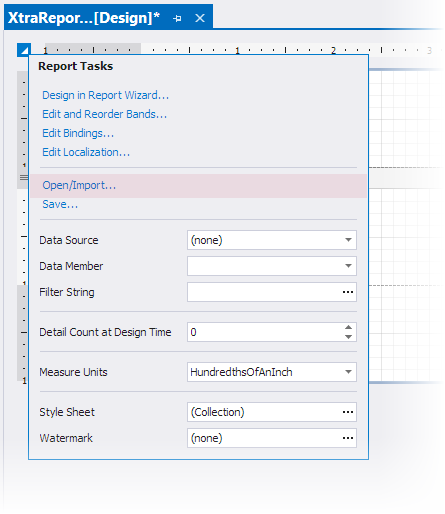Load Report Layouts
- 4 minutes to read
This document describes how to load a report from the report layout (report definition) file that contains serialization data.
Load Reports with the Report Designer UI
Click the report’s smart tag and select Open/Import in the actions list to load a report definition file. The default file extension is REPX.

The Import Report dialog displayed in Visual Studio enables you to import reports produced by third-party vendors. This option is not available in End-User Report Designers.

The End-User Report Designer UI for the desktop (WinForms and WPF) has an Open button to load reports.
The Web Report Designer enables the Open button if a report storage is implemented.
After you load a report, you may have to update data bindings. Refer to the following help topic for more information: Update Expression Bindings in Controls.
Load a Report in Code
Note
DevExpress Reports default configuration prohibits CodeDOM deserialization. CodeDOM reports can be a target of unauthorized code injections into a report’s definition. Harmful code can execute on a client machine during deserialization. We recommend that you use XML serialization to prevent such attacks.
For more information, refer to the following help topic: DevExpress Reporting - Security Considerations.
CodeDomLayoutDeserializationRestrictedException is thrown on an attempt to load reports stored using CodeDOM serialization. Set AllowCodeDomLayoutDeserialization to true at application startup to deactivate this exception. Note that this option applies to “Legacy API” listed below.
Use the following API to load reports and report style sheets in code:
Recommended API | Legacy API |
|---|---|
|
Loads a report from a file or stream that contains serialization data in XML format. Loads the serialized report definition from the specified XML file. Loads the report definition data from the specified stream and creates a report object from it. The created report’s class is also specified in the XML data format. |
Loads a report from a CodeDOM object model or from XML serialization data contained in a file or stream. XtraReport.FromFile and XtraReport.FromStream These static methods attempt to identify the report class type and deserializes a report to an instance of that class. The name of the report class type is stored in the header of the report definition. The report class type lookup is performed in the following assemblies (in the order specified below):
If the class type cannot be determined, a new instance of the base class XtraReport is created with the layout and settings loaded from the report definition file. |
XRControlStyleSheet.LoadFromXml Loads an XML containing a report’s style sheet from a file or stream. | XRControlStyleSheet.LoadFromFile and XRControlStyleSheet.LoadFromStream Loads a report’s style sheet from a CodeDOM object model contained in a file or stream. |
The following code loads a report from the file:
// A path to a report's definition file.
string reportFilePath = @"C:\Temp\Report1.repx";
// A path to a report style sheet.
string styleSheetFilePath = @"C:\Temp\ReportStyleSheet1.repss";
private void button1_Click(object sender, System.EventArgs e) {
// Create a report instance.
XtraReport1 report = new XtraReport1();
// Load a report's layout from XML.
if (System.IO.File.Exists(reportFilePath)) {
report.LoadLayoutFromXml(reportFilePath);
}
else {
System.Console.WriteLine("The source file does not exist.");
}
// Load a report's style sheet from XML.
if (System.IO.File.Exists(styleSheetFilePath)) {
report.StyleSheet.LoadFromXml(styleSheetFilePath);
}
else {
System.Console.WriteLine("The source file does not exist.");
}
}
For more information on report serialization, review the following help topics:
Secure Report Loading
The End-User Report Designer (WinForms and WPF) displays a warning when the user tries to load a potentially harmful report:

A report may introduce security-related vulnerabilites if it contains any of the following contents (including in its subreports):
If you have not yet done so, be sure to review the following help topic: DevExpress Reporting - Security Considerations.
Review the following help topics for information on how to ensure user security: